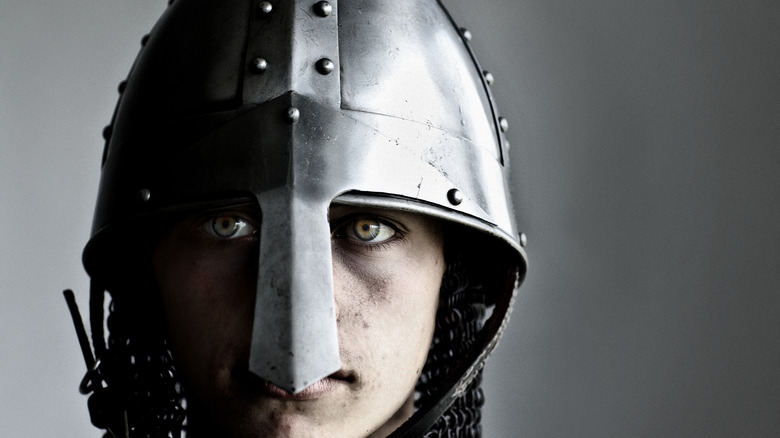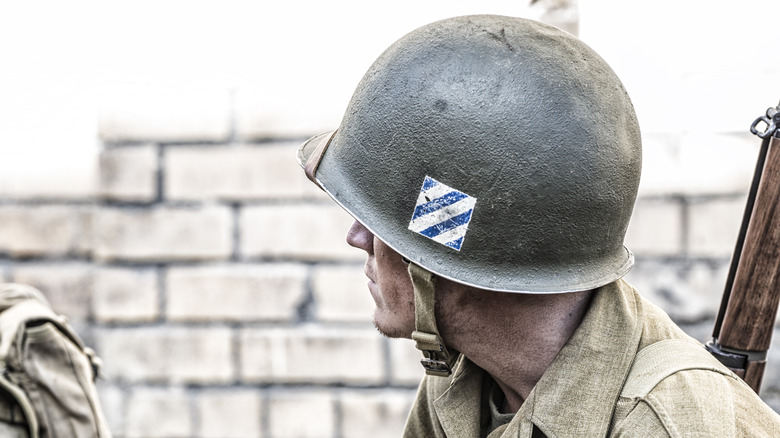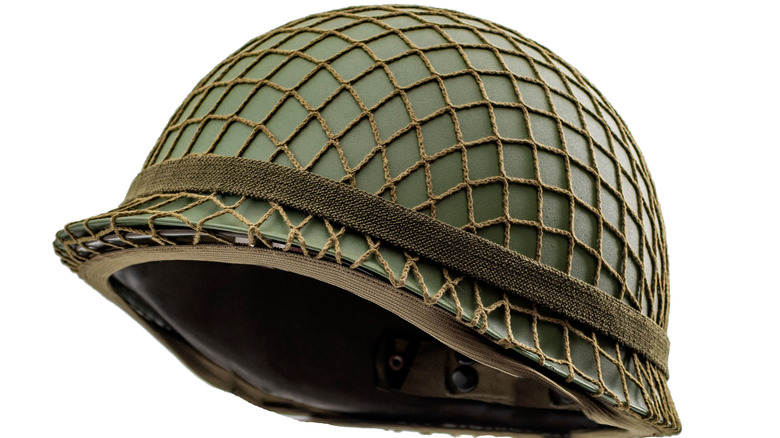
Duncan1890/Getty Images
What do the Akkadians, Greeks, Romans, and Americans all have in common? They all have combat helmets they wore in war. A warrior’s best weapon is his head, and therefore needs protection. Some of the earliest examples of combat head protection can we traced back to roughly 3000 B.C.and were constructed out of the tough hide of crocodile skin. Every warrior culture after would evolve the concept of the helmet, utilizing its technology to best protect its soldiers.
The Greeks developed the classic Corinthian helmet for their hoplites. These helmets were typically made out of one piece of bronze and could deflect (mostly) the arrows of the time. They tended to restrict a warriors ability to see, but it was a necessary trade-off. The rise of the Roman Empire would see the mass production of iron helmets. This helmet, referred to as the Galea helmet, weighed as little as 1.3 pounds, yet provided better internal padding and improved visibility. The Medieval period forward would see the iconic conical Nasal helmet of the Normans from the ninth to around the twelfth century. Typically constructed of single layers of iron, the helmet could way as much as six pounds, but as it could be worn over a coif of chain mail, it provided better protection. The Nasal helmet would give way to the enclosed helmets of the knight up through the 16th century. These helmets would completely enclose the head, which offered greater protection, but seriously restricted visibility and airflow. The use of iron, steel, and bronze in their construction made them extremely durable.
How the helmet evolved after World War I

Willowpix/Getty Images
The outbreak of World War I in 1914 would see millions of soldiers donning metal helmets. The nature of the war demanded better protection. The French had the Adrian helmet and the Germans the Stahlhelme, but the British and Americans would adopt the iconic M1917 Helmet, better known as the Tommy or Brodie helmet. Made from a single piece of steel in the shape of a soup bowl and weighing just 1.3 pounds, the Tommy only provided protection from above.
World War II saw the U.S. military utilize the M1 helmet. The helmet consisted of the outer shell made of Hanfield manganese steel and an inner suspension system. The helmet weighed 2.85 pounds and protected the head, sides, and neck, greatly improving on the Tommy. The M1 saw service through Vietnam and into the 1980s. Lightweight, composite materials such as materials such a kevlar, which afforded improved protection, led to the development of the Personnel Armor System for Ground Troops or PASGT helmet. The PASGT was between 3.1 and 4.2 pounds and utilized an internal adjustable pad system for comfort. Its replacement was the Modular Integrated Communications Helmet (MICH) also known as the Advanced Combat Helmet (ACH). At only 3.6-pounds, the MICH/ACH has a better fit and more protection through advancements in Kevlar material. The helmet integrates communication devices and can be outfitted with night vision. The Enhanced Combat Helmet or ECH, improves upon the protection capability of its predecessors, while maintaining similar weight.
What is the future of combat cranial protection?

Victor Moussa/Shutterstock
Combat helmets have improved in leaps and bounds since World War I, but what is the next step? The U.S. military sought to answer this with the establishment of the Helmet Electronics and Display System-Upgradeable Protection (HEaDS-UP) program in 2009. The result has been the Next-Generation Integrated Head Protection System or NG-IHPS. The NG-IHPS, according to product manager Lt. Col. Ken Elgort, «is a purpose-built platform for integration now and with future soldier-enabling devices.» The helmet offers multiple systems from visual augmentation to enhanced night vision and hearing protection, while weighing 40% less than the ACH. Issued to the first Army units in 2024, the manufacturer is contracted to provide over 190,000 helmets through September 2028.
Future helmets will be technologically advanced with augmented reality heads-up displays so troops can make better decisions in the moment. This new tech, in development since 2017, looks to provide soldiers with optimal routes to targets, data prioritization, mission planning and the ability to see threats through doors. These futurist helmets also need to merge weight with functionality, so new materials such as thermoplastics and copolymers can bring ballistic protection with reduced weight continues to be a major objective. The combat helmet will continue to evolve for the missions now and in the future.